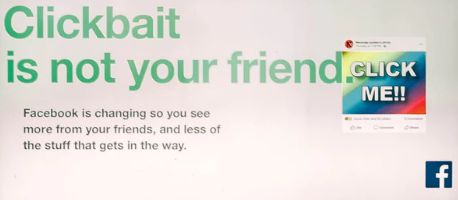
Like many people who spend too much time surfing the Internet on their smartphone, I am a bit of a sucker for clickbait stories. Human interest stories of childhood/young adult adventures, misadventures in retail or customer service that remind me of difficult positions I’ve held, or even basic interactions with people are spun into fascinating tales.
While some sites are nice enough to lay these out in a format that is pleasing to the reader, most of them become frustrating because they are also littered with ads. Popups in particular are annoying and will cause me to immediately leave the site in question because they are extremely aggravating.
The better designed sites use a different approach, and one that we can all learn from. That approach is what we are going to be discussing in detail today – banner ads. Aptly named for their banner-like nature in sidebars or across the top, middle, or bottom of a webpage, these typically display a catchy image or slogan and take you to another website when clicked upon.
Banner ads aren’t exclusive to mobile websites – a noteworthy percentage of desktop sites use them, too. Facebook and ESPN are just a couple very popular examples (though if you have a good ad blocker in your browser, you probably don’t see most of them when visiting their sites).
Despite their prevalence on the Internet, banner ads have a number of pros and cons to consider before you start implementing them for your business. We’re going to go over these in detail so you understand what they can and cannot do for your enterprise, how they are best implemented, and how effective they tend to be in the long run.
Jump ahead to:
Banner ads can be a vital tool for spreading brand awareness.

Many people quote the adage of a picture being worth a thousand words, and your banner ads can definitely capitalize upon this popular saying. A good banner ad is eye-catching and will stick with its viewer for a period of time after they initially notice it.
If nobody sees your ad though, all the effort that went into creating it is meaningless. Great banner ads go a step beyond the good ones by being put in front of the prospective customers most likely to care about your business.
While this sounds complicated, all you need to get started is knowledge of your target demographic. By selecting websites for your banner ads that are popular with the gender, age, and interests of your current customers, you’re maximizing their exposure by grabbing the attention of similar people. For example, if you’re targeting men between the ages of 18-45, sports websites like ESPN are often a great place to advertise (though this particular example will be very expensive).
Naturally, if you’re focusing on topics that mostly males of a certain age are interested in, then you don’t want your ads going on mommy blogs or blogs about wedding dresses and lingerie. You also won’t wont to advertise hunting gear on vegetarian/vegan websites or hockey gear in locations with tropical climates. Those aren’t going to do well for obvious reasons!
Finding out which websites are going to be hits and which are not with your target market is not always easy, but you can usually narrow down candidates by doing some research. You can go about this a few different ways, including Google searches for popular subjects, surveying your current customer base, or reaching out to reviewers of your most popular products.
Banner ads are usually not a tool for customer conversion.

Doing so ensures your message is seen without alienating potential customers.
If you are thinking of using banner ads to get more direct customer conversion, you are probably going to be disappointed by their results. Don’t believe me? Think back to my story about clickbait articles for a moment. I react to intrusive advertisements by either ignoring them when they are presented on a page or leaving the site if they are forced upon me.
Most online visitors are going to react the same way or at least pretty close to it – you might even be among them! This probably leaves you questioning the merit of banner ads at all, but they definitely serve an important purpose – it just requires a bit of psychological finesse to maximize it.
Let’s say you need to get a new car. You have an idea of features your car needs to have and things you’d like it to have. You might even have a general idea of the make and model going in. Car salesmen and dealerships as a whole do not enjoy a stellar reputation in our society, often coming off as pushy, sleazy, or rude, depending on the people you ask. Because of this, you elect to do some research online before setting foot outside your home.
There are three local dealerships that have a car that meets your needs.
- Company A advertises their business and website through banner ads on local news websites. They came up second in your Google search.
- Company B relies upon their website and SEO. They came up first in your Google search.
- Company C does no advertising at all. They came up at the bottom of Google’s first page.
Most people who are invested in their communities read the local news, and in this example, you are among them.
Of these three companies, which do you suppose you will be predisposed toward when you research these businesses? Company B might come up first in SEO results, but Company A is right behind it in second place. You’ve heard of Company A, so they are still going to be the first company you check, and they will serve as your baseline for comparing the others.
But if Company B came up first, why would that be? The answer is simple – people are inclined to trust something they already know over something they do not. This is why banner ads can be important despite failing to directly convert – you’re putting your name in the minds of those that see it, and the more they see it, the more they’ll acclimate to and remember it when they need you.
If you’re thinking you’ve heard of this tactic before, it’s probably because you have. Subliminal messaging has been around for decades, and while it isn’t nearly as overt as it was in television commercials in the 1950s and 1960s, it still plays an invisible role in brand marketing – banner ads just happen to be one of its more recent evolutions.
Banner ads are a tricky piece of an overall puzzle.

No two industries are going to be alike, and there are further differences when you look at companies that market locally, state-wide, nationally, or globally. This is one of the ultimate tests of cost-benefit analysis, as you plan to risk a certain investment in these ads for an indeterminate amount of reward over time.
Fortunately, we have a few insights to consider before you start digging into market data and research. Think of these as general thoughts to help get the ball rolling for the analysis your company requires – not hard and fast rules.
If your market is a small community where everybody knows each other (like the many in Iowa where I grew up), banner ads offer you virtually nothing. Word of mouth is king here, and banner ads should only be considered if you are expanding your market.
Bigger cities and state-wide markets can noticeably expand their brand awareness with properly utilized banner ads. Costs will usually be reasonable and you can often reach a lot of potential customers reliably with a bit of demographic research beforehand.
National banner ad campaigns can be a bit of a mixed bag. If you’re just starting out, odds are you won’t be able to easily reach the millions you want to due to the cost for putting an ad on a nationally popular website. If you’re big enough to have the funds, it is very possible you already have the following your ads are trying to establish.
Global campaigns should generally be broken into smaller national or regional markets. These will be at their best when you have a strong national presence and are looking to expand to foreign markets. Breaking such campaigns down is ultimately a lot more work, but being able to adapt to cultural customs and attitudes will ultimately resonate a lot more with your viewers.
Each of these scenarios are very simplified and will have a bit of subjectivity to them, so don’t be afraid to adjust your strategy as required. Different industries and businesses will have unique situations to consider, so what is normally right for most may not be right for your company in many cases.
How can I measure the results of my banner ad?
There are a couple of ways to do this. The first is to get an idea of how many people visited the webpage that has your banner ad on it. Most capable webmasters have some form of analytics built into their website, so they should easily be able to give you an idea of where you stand.
 The second way to do this is to engage with your customers. This can either be done by asking them how they heard about you in person (usually during the checkout process for brick and mortar locations) or through a simple survey question on your e-commerce checkout page or email marketing campaign.
The second way to do this is to engage with your customers. This can either be done by asking them how they heard about you in person (usually during the checkout process for brick and mortar locations) or through a simple survey question on your e-commerce checkout page or email marketing campaign.
A word of caution for this type of measurement – don’t devote more than one direct question to this metric during the checkout process. Your customers’ time is valuable and they will often be thinking about what they are going to be doing or where they are going to be headed next.
To get a good picture of your banner ad’s effectiveness, you should be prepared to measure this metric for an extended period of time (think 6 months to a year at minimum). Make sure any costs are budgeted for ahead of time, and be prepared to stay the course from start to finish. Accounting for busy seasons, slower times, special events, and other variables is only possible if you take the time to see how each impacts your banner ad’s performance.
In most cases, you’re probably only going to see a small trickle of people who saw your banner ad as their first point of contact, but that number should become significantly larger the longer your ad campaign runs. If you haven’t seen significant improvement in your results by the end of your campaign, you should either look to different websites for your banner ads or invest elsewhere with your advertising budget.
I think I can manage banner ads, but am looking for other options to be found online.
We can definitely lend a hand with that through our Search Engine Optimization (SEO) services. Give us a call at 319-229-5225 or send us a quick message through our contact page, and we’ll be happy to discuss options for improving the online presence of your business today!

Braden is one of the founders of Midwest Websites, and has been professionally writing and developing websites for over 7 years. His blog posts often take an experience from his life and showcase lessons from it to help you maximize online presence for your business.

